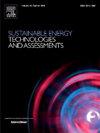Enhancing energy efficiency and profitability in microgrids through a genetic algorithm approach, analyzing the use of storage systems
IF 7.1
2区 工程技术
Q1 ENERGY & FUELS
Sustainable Energy Technologies and Assessments
Pub Date : 2025-01-01
DOI:10.1016/j.seta.2024.104154
引用次数: 0
Abstract
Due to intermittent, renewable energy systems struggle to meet demands efficiently and reliably. This research is rooted in photovoltaic systems, incorporating demand response optimization via genetic algorithms, generation forecasting using an artificial neural network, and integrating a storage system, looking for the optimal configuration to increase efficiency and system profitability. The investigation analyzes sunny and clouded seasons. Four scenarios are considered and compared to the baseline case. The baseline is the first scenario, which involves photovoltaics and a grid. In the second scenario, optimization focuses on photovoltaic generation using neural networks and incorporates demand response. The third scenario enhances the first one by introducing batteries. The fourth scenario refines the second one by including batteries. The simulations are developed using MATLAB, and an economic analysis utilizing HOMER is conducted. The findings reveal that the proposed artificial neural network exhibits superior root mean square errors at 443.62 W for photovoltaic forecasting, with an R-value of 0.9751. Applying the genetic algorithm results in a 15 % increase in self-consumption and a 52 % reduction in imported energy costs. The results showcase the model’s ability to minimize grid dependency and enhance efficiency. Economically, scenario two is the most favorable, achieving a payback of 3.6 years.
求助全文
约1分钟内获得全文
求助全文
来源期刊

Sustainable Energy Technologies and Assessments
Energy-Renewable Energy, Sustainability and the Environment
CiteScore
12.70
自引率
12.50%
发文量
1091
期刊介绍:
Encouraging a transition to a sustainable energy future is imperative for our world. Technologies that enable this shift in various sectors like transportation, heating, and power systems are of utmost importance. Sustainable Energy Technologies and Assessments welcomes papers focusing on a range of aspects and levels of technological advancements in energy generation and utilization. The aim is to reduce the negative environmental impact associated with energy production and consumption, spanning from laboratory experiments to real-world applications in the commercial sector.
 求助内容:
求助内容: 应助结果提醒方式:
应助结果提醒方式:


